Want to make your recruitment marketing techniques truly smart?
Then it’s high time you start exploring programmatic job advertising. (Yes, the industry has swiftly started adopting this idea!)
Let’s understand what it means and how this strategy can be a game-changer for you.
What is programmatic job advertising?
Programmatic job advertising is a digital recruitment marketing strategy that leverages advanced software and algorithms to automate the placement and optimization of job advertisements.
Through this approach, you can utilize data-driven techniques to target specific candidate profiles across various online platforms, including job boards, social media, and websites.
By analyzing user data such as browsing behavior, interests, and job search activities, programmatic advertising ensures that job ads are displayed to the most relevant audience.
And what makes it better than traditional job marketing?
Simply because of its efficiency and effectiveness, as it allows real-time bidding, razor-sharp targeting, and continuous optimization of ad campaigns.
Understanding the programmatic job advertising ecosystem in recruitment
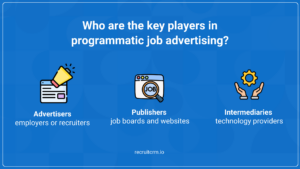
1. The key players
- Advertisers: These are the people looking to fill job vacancies. Their primary goal is to target the right audience with job ads, ensuring that their recruitment messages are seen by individuals with the relevant skills and experience.
- Publishers: For the display of job ads, various platforms come into play, ranging from extensive job boards to specialized, industry-specific websites. These are the spaces where advertisements gain visibility among job seekers.
- Intermediaries: This group includes technology providers that facilitate the programmatic ad buying and selling process. They are essential for connecting advertisers with publishers.
2. Demand-side platforms (DSPs)
DSPs are sophisticated software platforms used by recruiters and employers to automate the purchasing of digital ad space. Key aspects include:
- Automated ad buying: DSPs automate the process of buying ad space, removing the need for manual negotiations and placements. This automation makes the ad-buying process more efficient and faster.
- Targeting and optimization: They offer advanced targeting capabilities, allowing recruiters to specify the type of candidates they want to reach based on various criteria like location, skills, browsing behavior, and more. They also provide tools for optimizing ad campaigns, using data and algorithms to adjust strategies in real time for better performance.
- Data-driven decisions: By leveraging data, DSPs enable recruiters to make informed decisions about where and how to place their job ads for maximum impact.
3. Supply-side platforms (SSPs)
SSPs are used by publishers to manage and sell their digital ad space.
This is how they maximize the revenue potential of digital properties:
- Efficient selling of ad inventory: These platforms automate the selling of ad space, making it easier for publishers to fill their available inventory. They connect publishers with a wide range of potential advertisers, increasing the chances of selling ad space at optimal prices.
- Automated auctions: SSPs typically use real-time bidding technology to auction ad space to the highest bidder. This ensures that publishers get the best possible price for their ad inventory.
- Maximizing revenue: By providing access to a broad range of advertisers and automating the bidding process, SSPs help publishers maximize their revenue from ad space.
How does programmatic job advertising actually work?
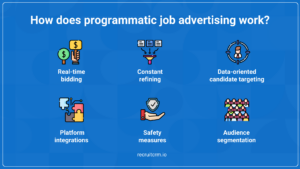
1. Real-time bidding mechanism
A critical component of programmatic job advertising is the real-time bidding (RTB) mechanism.
This process occurs in milliseconds, where DSPs bid on ad space in real-time as a webpage loads. The highest bidder wins the ad space, and their job ad is displayed to the potential candidate.
The major advantage of RTB is its dynamic pricing, meaning that the cost of ad space can vary based on demand, competition, and the relevance of the audience.
This means you have to pay a fair price for ad placements and can adjust your bidding strategies based on the performance of the advertisements.
2. Data-driven candidate targeting
At the heart of programmatic recruitment advertising is the use of algorithms and data analytics to target candidates effectively.
These algorithms analyze vast amounts of data, including job seeker behaviors, preferences, and online activities, to identify the most suitable candidates for a specific job ad.
By leveraging data, programmatic ads can target candidates who are not only qualified for the role but also more likely to be interested in the job opportunity.
3. Continuous optimization
One of the significant advantages of programmatic job advertising is its ability to continuously optimize ad placements.
The system tracks the performance of each ad, such as click-through rates, application rates, and cost-per-application. Using this data, the platform adjusts the ad placement strategy in real-time to improve performance.
For example, if certain job ads are not performing well on a particular website, the system can redirect the ad spend to more effective channels.
An ongoing optimization ensures that the recruitment budget is utilized effectively, maximizing the return on investment.
4. Integration with job boards and websites
Programmatic job advertising is not limited to a single platform or website. It integrates with a wide range of job boards, social media platforms, and other websites where potential candidates might spend their time.
This integration allows recruiters to expand their reach and tap into both active and passive job seekers.
By having a presence across multiple platforms, programmatic ads can attract a diverse pool of candidates, increasing the chances of filling the job vacancy quickly and efficiently.
5. Audience segmentation
Audience segmentation in programmatic recruitment advertising marks a significant leap from basic targeting, allowing recruiters to categorize the job market into distinct segments for more effective messaging.
Remember that the segmentation can be based on various factors such as career level, industry, job function, skills, company size, or geographic location.
With this approach, you can easily increase ad relevance, leading to higher engagement and application rates.
6. Brand safety measures
Brand safety in the field of programmatic ads is essential for maintaining your company’s reputation.
Programmatic platforms incorporate features to ensure job ads appear in appropriate contexts, using contextual targeting to place ads in relevant environments.
They also include tools to prevent ads from appearing on sites with potentially harmful content and let recruiters create whitelists and blacklists to control ad placements.
Real-time monitoring and compliance with ethical standards are integral to these safety measures, ensuring ads align with the company’s values and legal requirements, thus protecting the employer’s brand while reaching the right audience.
4 impactful benefits of programmatic job advertising
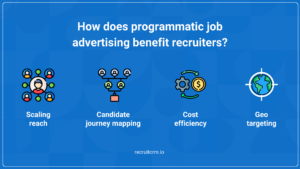
1. Scaling ad reach
One of the most significant advantages of programmatic job advertising is its ability to scale ad reach across multiple platforms and channels.
A programmatic ad campaign makes use of a network of websites, job boards, and social media platforms to ensure that job ads reach a broader audience.
An expanded reach is particularly beneficial for targeting passive candidates who may not be actively looking for a job but are open to new opportunities.
Here, the ability to reach a diverse audience also helps in filling niche or hard-to-fill positions.
2. Enhanced candidate journey mapping
Programmatic ads enhance the candidate journey mapping by meticulously tracking interactions with ads across multiple channels.
The tracking provides recruiters with a detailed understanding of how candidates engage with job ads, from initial exposure to application submission.
This way, you can identify which aspects of the ad campaign resonate most with candidates, enabling you to tailor future campaigns for better engagement.
Also read: What is candidate journey? Here are its top 11 touchpoints and ways to map them
3. Cost-effectiveness and budget optimization
Programmatic job advertising offers a more cost-effective approach to recruitment by optimizing ad spend based on performance metrics.
With real-time bidding, recruiters can set budget caps and only pay for ads that meet their criteria, such as cost-per-click or cost-per-application.
The approach here ensures that recruitment budgets are used more efficiently, yielding a higher return on investment (ROI).
4. Geo-targeting capabilities
Geo-targeting in programmatic job advertising is a powerful tool that allows recruiters to reach candidates in specific geographic locations.
This is particularly useful for roles that require local knowledge or expertise or when a company is looking to expand its presence in new markets.
Targeting job ads to candidates using a localized approach can ensure that their messages reach the most relevant audience in an area.
You might also like: How to leverage content marketing to supercharge your recruiting efforts?
8 advanced strategies to employ in programmatic job advertising
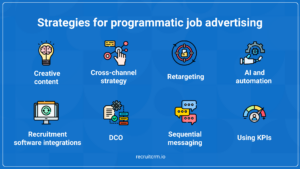
1. Leveraging creative content
The importance of engaging and creative content in programmatic ads cannot be overstated.
Creative content plays a pivotal role in capturing the attention of potential candidates and differentiating the job ad from the competition.
This includes using eye-catching visuals, compelling copy, and interactive elements that resonate with the target audience.
And don’t forget to tailor the content to reflect the company’s brand and culture, as it will help candidates get a glimpse of what it’s like to work at the organization.
Additionally, A/B testing different versions of ad content can help identify what resonates best with the target audience, allowing for continuous improvement and optimization.
2. Multi-channel and cross-device strategies
Implementing multi-channel and cross-device strategies ensures a consistent and seamless candidate experience across various platforms and devices.
It’s mainly about placing job ads on different types of media, including job boards, social media platforms, and professional networks, to reach candidates wherever they are online.
Also, It takes into account the increasing use of mobile devices for job searching, ensuring that ads are optimized for both desktop and mobile viewing.
By being present across multiple channels and devices, recruiters can effectively increase their ad reach and engage with a broader pool of candidates.
3. Retargeting techniques
Retargeting is a powerful technique in programmatic job advertising that re-engages candidates who have shown interest in a job but did not complete the application process.
It starts with tracking candidates who have interacted with a job ad or visited the career page and, followed by serving targeted ads as they browse other websites.
Retargeting helps keep the job opportunity top-of-mind for potential candidates and can be particularly effective in nudging those who are contemplating applying.
4. Utilizing AI for predictive analytics
Artificial intelligence and predictive analytics are increasingly being used in programmatic recruitment advertising to make more informed decisions.
AI algorithms can analyze large sets of recruitment data to identify patterns and predict the success of different advertising strategies.
It primarily includes predicting which job boards or platforms are likely to yield the best results, what type of ad content will engage the target audience, and how to allocate the budget for maximum ROI.
Predictive analytics can also help in identifying the best times to post job ads and forecast hiring trends, enabling recruiters to stay ahead of the curve.
5. Integration with ATS and HR systems
Integrating programmatic platforms with applicant tracking systems (ATS) and other HR systems enhances the efficiency and effectiveness of the recruitment process.
Such integration fuels a seamless flow of candidate data from the ad platforms to the ATS, enabling recruiters to track applications and manage candidates more effectively.
Integration also ensures that the candidate experience is smooth and consistent, from the initial job ad interaction to the application process.
6. Dynamic creative optimization (DCO)
Dynamic creative optimization (DCO) in programmatic job advertising is a strategy that leverages real-time data to automatically personalize ad content, enhancing its relevance and appeal to individual viewers.
This technology can modify various elements of a job ad, such as images, headlines, or job descriptions, based on the viewer’s location, browsing behavior, or profile characteristics.
For instance, a job ad could display different benefits or company culture aspects depending on whether the viewer is in an urban or rural area.
DCO’s ability to tailor content on the fly makes ads more engaging and effective, increasing the likelihood of attracting suitable candidates.
7. Sequential messaging
Sequential messaging is a nuanced strategy in programmatic ads where candidates are exposed to a series of ads that collectively tell a story or progressively reveal more information about the job and the company.
It is designed to build a narrative over time, engaging potential candidates by gradually providing deeper insights into the company culture, job roles, career growth opportunities, and other unique selling points.
Sequential messaging can effectively nurture candidate interest and engagement, guiding them through a journey that culminates in a strong understanding of the job opportunity and a higher likelihood of application.
8. Using key performance indicators (KPIs)
In programmatic job advertising, key performance indicators (KPIs) are essential metrics used to evaluate the effectiveness of ad campaigns. Common KPIs include:
- Click-through rates (CTR): This measures the percentage of viewers who click on an ad after seeing it, indicating the ad’s ability to attract attention.
- Cost-per-click (CPC): This tracks the average cost incurred each time a job ad is clicked, helping to gauge the financial efficiency of the campaign.
- Cost-per-application (CPA): CPA measures the cost associated with each application received, providing insight into the ad’s effectiveness in converting viewers into applicants.
- Quality of applicants: This KPI assesses the relevance and suitability of applicants for the job role, ensuring that the campaign attracts the right candidates.
These KPIs collectively offer a comprehensive view of a campaign’s performance, guiding recruiters in making data-driven decisions to optimize their advertising strategies.
10 top programmatic job advertising platforms recruiters should give a try
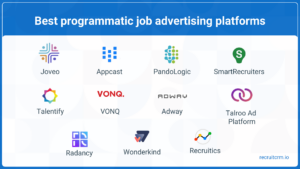
1. Joveo
Joveo stands out with its advanced machine learning and AI capabilities, which are instrumental in optimizing campaign performance.
Its real-time bidding system ensures efficient ad placement, and its user-friendly interface simplifies campaign management, making it accessible for recruiters of all skill levels.
2. Appcast
Appcast is renowned for its extensive reach, making it a go-to platform for recruiters looking to cast a wide net.
The platform provides detailed analytics and performance tracking, enabling recruiters to gain deep insights into their job ad campaigns and make data-driven decisions.
3. PandoLogic
PandoLogic utilizes AI to automate and enhance the efficiency of job ad placements.
The comprehensive analytics and reporting tools it comes with can offer a detailed view of campaign performance, helping recruiters to fine-tune their strategies for better outcomes.
4. Talroo Ad Platform
Talroo specializes in reaching unique and often hard-to-find audiences.
It provides targeted ad placement tools, making it ideal for niche or specialized recruitment needs where specific candidate pools are sought.
5. Radancy
Radancy offers a unified talent acquisition platform that integrates programmatic ad capabilities with robust analytics.
This all-in-one solution is particularly beneficial for organizations looking to streamline their recruitment marketing efforts.
6. Recruitics
Recruitics provides a data-powered recruitment marketing platform that emphasizes automation and job distribution.
Its features are designed to simplify the complexities of recruitment marketing, making it easier for recruiters to manage and optimize their campaigns.
7. Wonderkind
Known for its talent attraction technology, Wonderkind excels in job feed management.
The platform is adept at identifying and attracting passive candidates, a crucial aspect of modern recruitment strategies.
8. Adway
Adway specializes in social media-based programmatic advertising, leveraging popular platforms like Facebook and Instagram.
This approach is particularly effective for targeting younger demographics and tech-savvy candidates.
9. Talentify
Talentify is known for its user-friendly interface, which simplifies programmatic ad placements.
Their platform is designed to be intuitive and accessible, reducing the learning curve for recruiters.
10. VONQ
VONQ offers strategic programmatic advertising solutions with a focus on goal setting and campaign optimization.
It’s geared towards achieving specific recruitment objectives, making it ideal for targeted recruitment campaigns.
5 ways of implementing programmatic job advertising in recruitment
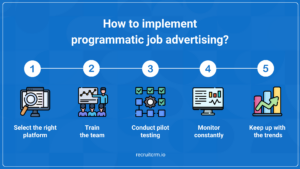
1. Evaluating and selecting platforms
The first step in implementing programmatic job advertising is to evaluate and select the right platforms.
You need to go all out when assessing various demand-side platforms (DSPs) and other programmatic advertising tools for their features, compatibility with existing systems, and ability to meet specific recruitment needs.
Key factors to consider include the platform’s reach, the sophistication of its targeting capabilities, integration options with applicant tracking systems (ATS), and the analytics and reporting tools it offers.
It’s also important to consider the platform’s user interface and ease of use, as well as the level of customer support provided.
2. Training and development
Once a platform is selected, the next step is to provide comprehensive training to the recruitment team.
This training should cover how to use the platform effectively, including setting up campaigns, choosing targeting options, and interpreting analytics.
Ongoing training may also be necessary to keep the team updated on new features and best practices in programmatic advertising.
Also read: 10 ChatGPT prompts recruiters can use to train AI & reduce workload in half
3. Pilot testing and scaling
Before fully implementing programmatic recruitment advertising, it’s advisable to start with pilot testing.
That means running a small-scale campaign to gauge the effectiveness of the platform and refine the advertising strategy.
Pilot testing helps identify any potential issues and allows for adjustments before scaling up the campaign.
Once the pilot test is successful and the strategy is refined, the campaign can be scaled up gradually.
4. Continuous monitoring and adaptation
Programmatic job advertising requires continuous monitoring and adaptation to ensure optimal performance.
This involves regularly reviewing campaign analytics to assess the effectiveness of different ad placements, targeting strategies, and creative elements.
Based on these insights, adjustments can be made to improve campaign performance, like changing targeting criteria, reallocating the budget to more effective channels, or tweaking ad creatives.
5. Staying updated with industry trends
The field of programmatic job advertising is constantly evolving, with new technologies, platforms, and strategies emerging regularly.
To stay competitive, it’s important to keep up with industry trends and developments. This can be achieved through industry publications, webinars, conferences, and networking with peers.
Staying updated allows recruiters to leverage the latest tools and strategies, continually improving the effectiveness of their programmatic ads efforts.
Programmatic job advertising is nothing but a MAJOR step ahead into the world of smart and efficient recruitment practices. For recruiters in dilemma, this is your chance to get ahead of the race, DO NOT miss out.
Frequently asked questions
1. How does programmatic job advertising impact the diversity of the candidate pool?
Programmatic job advertising can enhance diversity by using unbiased algorithms for ad targeting, reaching a broader and more varied audience, and reducing unconscious bias in the recruitment process.
2. How does programmatic advertising ensure data privacy and compliance?
Programmatic platforms adhere to data privacy laws and regulations, using secure data handling practices, anonymizing candidate data, and providing transparency in data usage to ensure compliance with legal standards like GDPR and CCPA.
3. How does programmatic advertising adapt to changes in the job market?
Programmatic advertising is highly adaptable, using real-time data and market trends to adjust campaigns dynamically. This flexibility allows it to respond quickly to changes in job market demand and candidate preferences.




